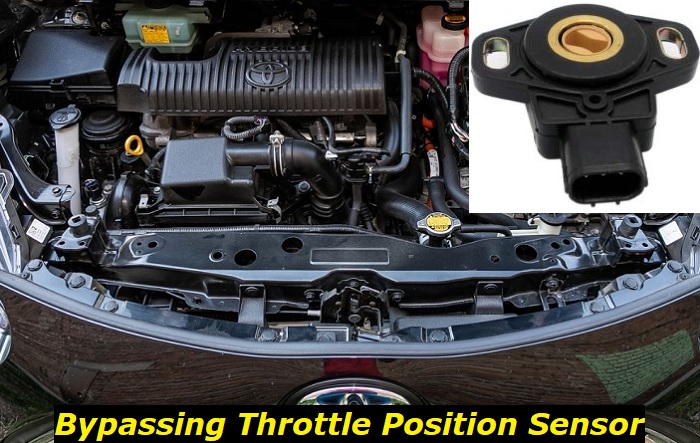When most of us think about our vehicle, the Throttle Position Sensor (TPS) is not exactly the first thing that pops in our mind. In fact, many owners tend to believe that the Throttle Position Sensor (TPS) is just not that important and can even be bypassed. However, this sensitive little sensor is an essential component and plays a huge role in your vehicle's ability to function properly.
Electrical problems leading to RPM anomalies highlights
- DIY repairs:possible but complicated
- Tools needed:inspection and repair tools
- Commonreasons:idle control valve, throttle position sensor, wiring, software
- Time to repair:1 - 2.5 hours
- Price for parts:$50 - $300
- Can you drive?Yes
- Alternative solutions:unplugging sensors, resetting or relearning sensors

What is a Throttle Position Sensor and what does it actually do for your vehicle?
The Throttle Position Sensor is a part of the vehicle's throttle body system. Found between the intake manifold and the air filter of the engine, the TPS is responsible for determining the throttle position and communicating it to the Engine Control Module (ECM). The information from the TPS is used to calculate the perfect air-fuel mixture for your vehicle's engine.
Remember, engines require an accurate ratio of air and fuel mixture to function properly. Therefore, as input for the combustion of the engine, an exact and specific amount of fuel and air must be conveyed to the engine. The Throttle Position Sensor (TPS) informs the ECM regarding the condition of the engine air intake or just how much air is being sucked in at any moment by the engine.
Whenever you press down on the gas pedal, the valve of the throttle body unit rotates and opens up. As it opens, it allows a calculated amount of air to enter the combustion Chamber through the intake manifold of the engine. The harder or more the gas pedal is pressed, the more the valve opens up.
During this stage, a signal is sent out by the Throttle Position Sensor (TPS) to your car's computer, reporting the valve's position. The ECM is able to determine the exact amount of fuel to send for the engine and can create an ideal condition when it knows how much air is coming in. So an equivalent amount of fuel is administered into the chamber to ensure enough combustion can take place.
Most modern cars depend on their computer system to collect accurate information/data continuously to optimize the vehicle's performance. Without the Throttle Position Sensor (TPS) working properly, it will be difficult to calculate the ideal air/fuel mixture and cause issues with idling and acceleration. So the TPS must be plugged in and functioning properly to be able to have complete control of your acceleration and drive safely.
Consequences of Bypassing or Malfunctioning Throttle Position Sensor
When a person puts their foot on the gas pedal, they automatically expect the vehicle to accelerate, right? Well, that automatic expectation can sometimes fail and that will not only affect the performance of the vehicle but also put the driver in a very dangerous situation. One of the most common culprits behind this issue is related to the Throttle Position Sensor.
Back in the old days, there used to be a wire attached to the gas pedal to respond to the movement of how the pedal is pressed. However, now in modern times, there is an electric system with a much more systematic and productive output. Modern vehicles use the Engine Control Module (ECM) to monitor most of the sensors and manage the air-fuel mixture as well as regulate the emission control system.
The ECM receives the accurate air intake information of the engine from the Throttle Position Sensor (TPS). Therefore, the TPS has a huge role in how much air and fuel goes to the engine, and without it, you will experience rough runs and dangerous acceleration issues. Driving under such conditions can cause harm to yourself as well as to other drivers and even pedestrians near or around your vehicle.
The engine in your vehicle is the most complex and sensitive component and requires all other related parts including the TPS to work in perfect harmony. Hence, depending on the model and year of your vehicle, the engine can stall when you press on the gas pedal or may not even start at all if you happen to unplug and try to bypass the TPS.
The TPS is significantly crucial and always best to make sure it is plugged in and working properly for vehicles to run with accuracy and avoid any mishaps on the road.
Common Symptoms of bypassing or a faulty Throttle Position Sensor
Bypassing or even dealing with a faulty Throttle Position Sensor (TPS) can have you stranded alongside the highway and end up shelling out a lot of money for repairs. What may be even worse is losing control of your vehicle as it is possible for the car to accelerate on its own. Below are some of the most common symptoms related to bypassing, unplugged, or a faulty TPS for you to pick up on and avoid any risks of damaging your engine and potential accidents.
- Acceleration/Power Issues
When your Throttle Position Sensor (TPS) is not plugged in or malfunctioning, that causes the engine to receive an inconsistent supply of fuel. So that means the engine may not get the required amount of fuel, or vice versa, too much than needed at the time. These types of conditions can open up the door for many different types of acceleration and power issues.
Without the TPS sending out the correct information, the engine in your vehicle may start up at first but will have very little to no power and eventually die out after a brief run. Also with a fluctuating air/fuel flow, you may experience a weaker acceleration than expected. Furthermore, this may even cause your vehicle to have impulsive power surges.
Normally when you step on the gas pedal to increase speed, the TPS cries out for more fuel and that amount of fuel is provided for you to accelerate. However, without the TPS providing that information, you may experience a lack of power and fail to increase speed. On the other hand, you may get more power than expected when you ease up on the pedal due to the engine receiving too much fuel.
Issues with acceleration and power can lead to other parts being damaged and most importantly, be very risky for the driver. Not having full control of the acceleration is not a situation anyone wants to be in on the road, especially with other cars and pedestrians nearby. Therefore, bypassing your Throttle Position Sensor or even neglecting a faulty one is hazardous to your vehicle, yourself, and others.
- Uneven Idle
When idling, your engine should be steady and you will be able to hear a pretty even sound from your vehicle. To maintain a steady idle, it is very necessary to have a constant fuel delivery level. Therefore, if your vehicle's TPS is unplugged or faulty, the inconsistent flow of air/fuel will cause rough or unusual idling consisting of shakes and jerks.
- Poor Fuel Economy
Working alongside other sensors, the Throttle Position Sensor (TPS) strives to ensure that the engine has everything needed to run smoothly. Without the TPS, the computer system does not receive the correct data and the ECM fails to sufficiently regulate the amount of fuel it sends to the engine. As a result, the engine might end up receiving more fuel than it actually needs.
In that case, the computer will try to compensate to rebalance the air/fuel mixture by injecting excess fuel. This will cause your vehicle to be less economical and consume more fuel than it would if the TPS was plugged in or working properly. So bypassing or neglecting a faulty TPS will not only cause damage to your vehicle and put you in danger, but also increase your daily fuel expenses.
- Difficulty Switching Gears
If your vehicle has an automatic transmission, then an unplugged or faulty Throttle Position Sensor can cause shifting issues on the road. The TPS establishes the immediate driver's intent and sends that information to the Transmission Control Module. Therefore, you will have difficulty switching gears or experience delays if the current and accurate data is not sent promptly.
Conclusion
Without the Throttle Position Sensor (TPS), the Engine Control Module (ECM) in your vehicle lacks critical information which it needs to execute its responsibilities. Therefore, the ECM has no way to monitor the amount of fuel the engine needs nor effectively time the ignition.
As a result, you may experience spontaneous surges or on the other hand, your vehicle may lack power and stall or go into Limp-Mode.
Unfortunately, those are some very dangerous situations to be in while driving on any road. Unplugged or a faulty Throttle Position Sensor (TPS) can cause damage to your engine/other related parts and put the driver and others on the road in a very risky situation.
Therefore, not only shouldn't you bypass the Throttle Position Sensor (TPS), but also make sure it is working properly at all times to keep yourself and others safe on the road.
About the authors
The CarAraC research team is composed of seasoned auto mechanics and automotive industry professionals, including individuals with advanced degrees and certifications in their field. Our team members boast prestigious credentials, reflecting their extensive knowledge and skills. These qualifications include: IMI: Institute of the Motor Industry, ASE-Certified Master Automobile Technicians; Coventry University, Graduate of MA in Automotive Journalism; Politecnico di Torino, Italy, MS Automotive Engineering; Ss. Cyril and Methodius University in Skopje, Mechanical University in Skopje; TOC Automotive College; DHA Suffa University, Department of Mechanical Engineering






Add comment